The Nightmare Before Christmas: Why Being Unique in Hollywood Still Matters
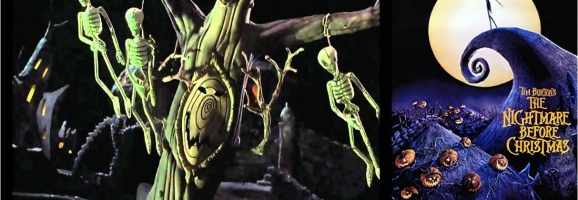
The inescapable marriage of sight and sound is what makes a movie great, versus being another average film amongst the many. Sound is not limited to the static dialogue, but more about how the dialogue influences the characters and the scene. Sight is not just the movement on screen, rather movement in connection with the other characters and, more importantly, the viewer. In Tim Burton’s A Nightmare Before Christmas, this union between sight and sound in film became ever more prolific. He used a visually impressive art-form that changed how characters interacted with each other, effecting the flow and sight of the movie; coupled with original music scores and a unique dialogue experience.
Tim Burton: The Real ARTful Dodger
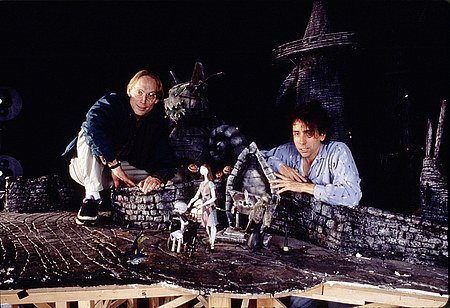
An important element of the movie comes from the artistic approach Tim Burton decided to go with regarding visualizing the script. Instead of following the traditional Disney trend by simply making another animated film, he decided to take a chance with an art form that wasn’t proven on the large screen. The idea of using a stop motion technique with clay figurines, or Claymation, was not a new idea, but for a full-length feature film it would be considered extremely tedious and troublesome. These minute changes make the characters move just slightly slower than they would in real-time or when digitally animated, meaning a raising of the hand or turning of the head, are much more dramatic. Every scene where a character is walking across the backdrop, is like watching a dancer gracefully move across the stage or an ice skater perfectly in sync with the music. The final scene is a great example of these diminutive changes in posture adding to the drama of the movie. Watching Jack and Sally come together, they appear to “skate” across the scene in each other’s arms.
With Claymation, comes the painstaking task of forming minute changes in the figures position in order to make a scene. Something is captured in these moments that real life motion cannot naturally achieve. The tedious work of making a scene may have inadvertently added to the movie’s artistic style because each scene made you stay with the character, which helps immersion. The scene where Jack is under attack by the army after he had been impersonating Santa Claus is a brilliant example of this technique. He is being heavily bombarded by artillery, but the camera angle barely changes perspective, keeping you planted in the scene, not able to escape, much like Jack. Tim Burton proved that you can have action and drama, without giving the audience seizures with over-the-top action sequences and moving the camera all over the place trying to experience an explosion.
Jack’s Lament and Sally’s Song
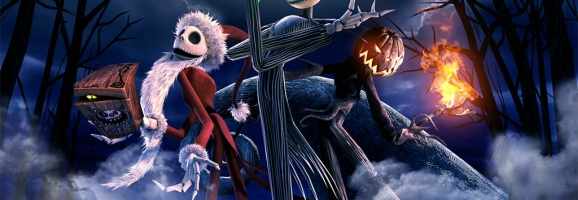
When movies reach a certain level of popularity, certain elements tend to stand out more than others. When asking people, one will undoubtedly uncover what about that particular movie is standing out in people’s minds. With Die Hard it’s about the action and dialogue, with The Godfather it’s about the cinematography, with Good Will Hunting it’s all about the writing, etc. A Nightmare Before Christmas is no different. Anyone who watches the film, for no more than twenty minutes knows the pivotal role music plays. Danny Elfman not only wrote and produced the soundtrack, but also provided the singing voice of Jack Skellington. The entire movie swims in music and rhythmic tones, from simple dialogue between characters, to the grandiose cut-scenes.
A Nightmare Before Christmas was released at a time that was very climatic for music in film because it was becoming a dying art. A movie’s soundtrack has always been a huge part of what connects audiences to a movie, but during the latter part of the century, it became more and more prevalent to just add popular songs to a movie soundtrack. While this helped to attract more people to the movie, less creative control over the flow of the movie became a negative side effect. Movies always work better when a song is made for it, versus a song that just compliments it. This became more ubiquitous with non-animated movies first, and even Disney wasn’t immune to this influx of outsourcing music in movies.
A lot more non-animated movies were guilty of this practice first, but the closer towards the end of the century we got, the more animated films incorporated outside artists to help fill their movies. When a person is immersed in a scene and a popular song starts to play, that connection can be lost, and the viewer goes from the movie to thinking about the song and the artist, completely killing their emotional involvement in the scene. The best scene that exposes this dilemma is when Sally sings ‘Sally’s Song’. She feels as if Jack is blinded by ambition and that he can’t see the potential danger of his actions, even though her infatuation with him never wanes. Could Whitney Houston, Mariah Carey, or any other popular female artist sing one of their love songs and make it fit? The answer is absolutely, but it would not have been as impactful as a song written specifically for that moment, sang by the actress herself. Tim Burton and Danny Elfman foresaw the problem, and allowed Catherine O’Hara (voice of Sally) to sing all of her own parts.
The Gift of Gab
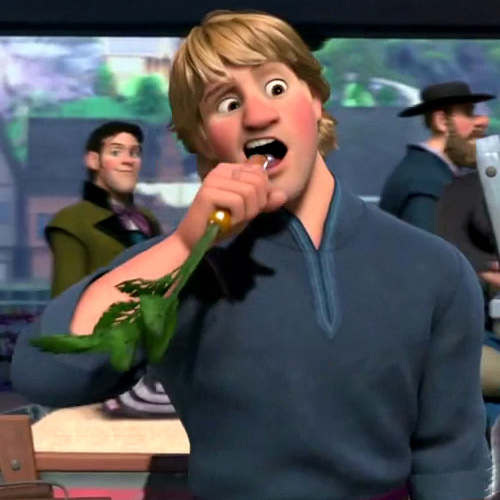
The film followed a Mary Poppins approach to its dialogue, having each conversation between characters in a song-like form. It was as if each interaction between characters was either at the end of a song or was leading into a song. Directors and producers tend not to play music while there is dialogue between characters because it can be distracting to an audience. How Tim Burton and Danny Elfman overcame this issue during scenes of intense dialogue, was to subtlety play music in the background, and then present the dialogue as a rhythmic dance of words between the characters. The best scene to observe this technique is the fight sequence between Jack and Oogie Boogie. It is as close to Jets versus Sharks as one can get, without completing ripping off Westside Story. If you observe the movie from this perspective, you will notice that the music quietly begins to sneak up on you, then crescendos with the song of that moment.
Sometimes it is easy for us as movie watchers to get so caught up in the visual interpretations on-screen, especially in a movie like this one, that we overlook how the dialogue is influencing us on an emotional level. One would not expect the Pumpkin King to be an understanding and somewhat soft spoken ruler of all things scary, yet that is exactly how Jack is portrayed. The intense passion he has for the townsfolk, and how he speaks to them with such care, helped make Jack an endearing character, and maybe the most underrated leading man in any movie.
The Greatest Love Story Never Told
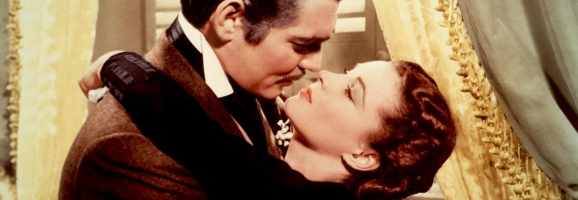
On the surface, The Nightmare Before Christmas, is nothing more than a children’s movie made for the holiday season crowd. There is the obvious Christmas themed setting with all the characters looking as though they were spawned out of Gumby’s worst dreams. Tim Burton and the crew did a masterful job at giving the kids something to keep them entertained, while giving the older generations the Claymation version of Gone with the Wind.
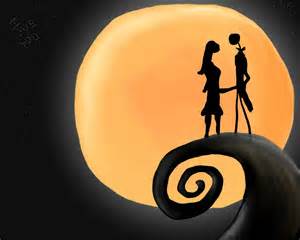
Once Sally comes into the picture, literally and metaphorically speaking, the intent of the movies’ writers becomes more evident. There are scenes where the relationship between Jack and Sally almost mirror Scarlett (Vivian Leigh) and Rhett (Clark Gable). An undying devotion destined to be marred by fate, only to be reconciled by true love. One can see Jack’s hijacking of Christmas as the Civil War and Oogie Boogie as the Confederates. No scene more depicts the contrast between the two sets of lovers like the final scene where Jack and Sally finally come together, with that huge beautiful moon in the backdrop. The only thing missing was Jack leaning over to Sally and saying, “Frankly Sally, I don’t give a damn!.”
The Nightmare that Saved Movies: The Lasting Legacy of Tim & Jack
No one will argue that that movie industry is still being carried by superhero blockbusters like The Avengers, Deadpool, Captain America, etc. Movie goers are flooded with CGI characters and zany special effects, but the uniqueness of The Nightmare Before Christmas is still very much alive in Hollywood and is still influencing movie makers to this day. With movies like The Fantastic Mr. Fox, Coraline, Wallace & Gromit, Chicken Run, Corpse Bride, and a slew of others; Tim Burton’s approach proved to be everlasting and far reaching.
Originality is the key for longevity in a creative industry. No amount of marketing or pop culture references can ever influence a movie like good dialogue, a unique perspective, and original scores. A Nightmare Before Christmas proved that with a unique perspective on old themes, a movie can rise above the fray and be more revered for how it was made, rather than why it was made.
What do you think? Leave a comment.










The first time I saw this movie, I was 16 and had taken a considerable amount of acid that evening. I thought it was mind-bogglingly fantastic, but the experience was significantly intense to put me off from rewatching it for about a decade.
Since seeing it again, I still think it’s an excellent movie, particularly as a piece of children’s entertainment that is equally enjoyable to adults. Our collective perspective on that kind of film has changed a bit over the last decade, due to the consistently terrific Pixar films and others such as Coraline, and we have an increased expectation of finding films that do fit that bill and satisfy both audiences equally.
But when Nightmare came out, that was still an extremely rare commodity, and I think it’s worth recognizing it as being fairly revolutionary at the time for achieving that distinction. I also can almost never tolerate movie musicals, but the songs are pretty well composed and distinctive, and rarely distracting from the story.
And for me, any film that performs stop-action animation with such loved and devoted attention to detail and character design will inevitably satisfy me, and intensify my disdain for CGI-animated films that fail in that respect (the richly detailed Pixar films, of course, being a huge exception).
I literally wore this VHS to extinction.
I will always and forever luv this movie. It was things like THIS that made people think Tim Burton was a revolutionary creator. Because he was. Not is, but was.
This was the first movie I saw at a midnight premiere (University Square in Madison, RIP) and it was awesome is the truest sense of that word.
This was the first movie my daughter ever saw in the theaters. The timing was perfect: she was just old enough to sit still for an hour and a half, she had already seen it, and it was just getting re-released for the first time in 3-D. She was enthralled. Win.
I think that the movie does have a strong lesson about being brave enough to take creative risks, even if you wind up falling on your face.
I’ve seen it once – a friend invited a few pathetic single people over for Thanksgiving, and she and her roommate always played three movies after Thanksgiving dinner (none of which I’d seen). This, Christmas Vacation and Scrooged. As this was the only one I found even slightly tolerable, I probably gave it too much credit, but it never grabbed me. It felt like some people had some great ideas for some puppets, then figured they could throw in some songs and the movie would sort of write itself. Like a brilliantly-photographed art-house snorefest.
Try it again. the first time I saw this in the theatre, I hated it. Watched it later at home and it started to grow on me. I love it now.
I remember not being particularly impressed by it as a kid until the demise of Oogie Boogie. When he started screaming MY BUGS MY BUGS I knew I would have nightmares that night. And I did.
I still unobjectively love the hell out of this movie, and I always will. End o’ story.
Enjoyed your piece and it doesn’t help to be overly critical but Selick should be credited under the photos of the film as he was the director. Also, feel you somewhat left out that Selick was the driving force of the film and his influence as shown by Laika’s output.
I was going to mention the same thing. Selick was not mentioned once and it really was his baby, imo.
The dizzying attention to detail is definitely the best part now that I’m older and have an appreciation for the time and painstaking concentration that was put into making the film. It took them something like two years to complete the filming. To make a 75 minute film. That’s dedication that I don’t think I could give to anything.
It’s a well made film.
But when I got to art school in the early 90’s, the SUPER arty kids ran this and the Crow into the ground, so I suffer from overkill when i comes to NBC. Plus, all the songs sound the same to me…
The very definition of a goth who doesn’t take themselves too damn seriously is knowing the words to This Is Halloween and singing along with gusto.
The first time I watched this, it didn’t even occur to me that it was claymation. I had seen “Wallace and Gromit” and of course those old Christmas movies that were created with stop motion or claymation, but somehow this movie had a fluidity in the characters’ movements that simply stuck out at me as fantastical and unique.
And you’re totally right – the specialness of Burton’s choices and this movie as an ambitious feature film using clay animation with musical elements still has resonating effects on movie-making today. The box office might be dominated by the likes of superheroes, Disney princesses, and action-packed thrillers, but I think this remains an important hallmark in the industry.
The movie is a hybrid of stop-motion and computer generated effects, and it was one of the first (if not the first) done in this particular style. Thus a lot of the technical aspects are very rough: cinematography, facial expressions/syncing, camera movement, etc. It’s all very ambitious, but it was definitely an early draft for more (technically) successful flicks like Coraline and Corpse Bride.
I think this is my favourite Christmas movie (or close to it). Maybe that says more about the quality of Christmas movies that it does about Nightmare, but whatever. I like it quite a bit and find myself watching it every couple years, sometime in November or December.
I love this idea of the psychology behind what connects and audience to the movie. It is interesting that simple details with music within a movie will make or break that connection. I agree with what you said that it is the best marketing technique!
I’m currently teaching English in Hungary, and I’m kicking myself for not bringing my copy of TNBC with me, because it would have been awesome to have been able to show clips and be like, “This is pretty much what Halloween is all about in America, kids.”
I saw this movie for the first time when I was in college, because my parents were super conservative and didn’t like how macabre the movie looked in the trailers. (Parental FAIL.) I think it’s awesome. I’m a sucker for stop-motion animation (and Danny Elfman).
I adore this movie. But as a bad parent, I let my daughter watch it when she was four. She liked the songs, but there was one time when I heard a high-pitched sound coming from her, and I asked what it was. She replied “oh, that’s just me screaming.”
I might have emotionally scarred her forever! But now she runs around saying “This is Halloween” so it isn’t a total loss.
Love this movie! 😀 I adore every bit of its artistic merit and quality. First time I saw it was as a kid, but there was an odd period where I forgot this movie existed. It became like a weird dream…before I rediscovered it for the gem it so is.
This movie scared the shit out of me as a kid, couldn’t even look at toys of Jack, and it was all from the opening. It’s one of those movies that when the time of year comes around you can pop it in and watch it and never get sick of it. It’s seasonal for sure, but one of the better ones.
„[Y]ou can have action and drama, without giving the audience seizures with over-the top action sequences“ – that seems to be more apparent with every new 3D, superhero, overblown-hyped film coming out, alike the recurring battles between dwarfs and elves, robots and aliens. All happening in front of a blurred out background without any attention paid to detail, making it easy for the eyes but rather bland for the mind. Burton’s eye for detail and intrepidity in challenging his audience, advances him out of the ordinary and into an outstanding filmmaker, who proves „Originality is the key for longevity in a creative industry“. Well written take on the mechanisms of the entertainment industry, and the connection between creator and audience.
I agree with this article. Creativity always overrules everything else.
I believe this movie is great. And I agree, being unique and creative is essential to make movies. I think that the movies that are produced independently provide the filmmakers a better space to do it.
I still can’t decide if this is more appropriate for Halloween or Christmas, so I simply must watch it for both. “This is Halloween” is one of my favorite Halloween songs!
I will never get over how beautifully and methodically crafted the claymation in Nightmare Before Christmas – a true work of art. Hope to see equally brilliant claymation works in the future, fingers crossed people take more of an interest in this art-form.
Mikey, what a well-written argument supporting such a beautiful piece of art. I have always had a superficial love for Danny Elfman’s music in this film, but I never took the time to internalise and analyse it. Thank you for taking this time to write this. It has really opened my eyes to something I knew was there but never really understood.
I’ve never seen this movie (just clips), but your article makes me eager to check it out. Thanks.
A good essay. I always enjoyed watching this movie with my children–it was an odd Christmas movie. We added it to the mix of movies we saw at Christmas that were actually Christmas movies. In some ways I think that it is a, sort of, Christmas movie without being a Christmas movie. That helps to make it a movie people, not just children, want to see at Christmas–a change of pace, you might say.